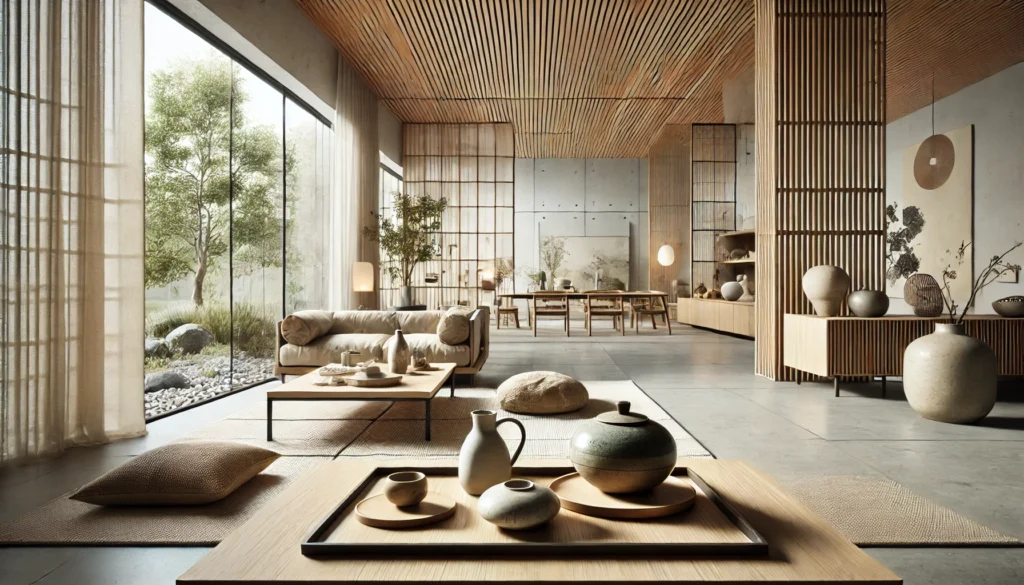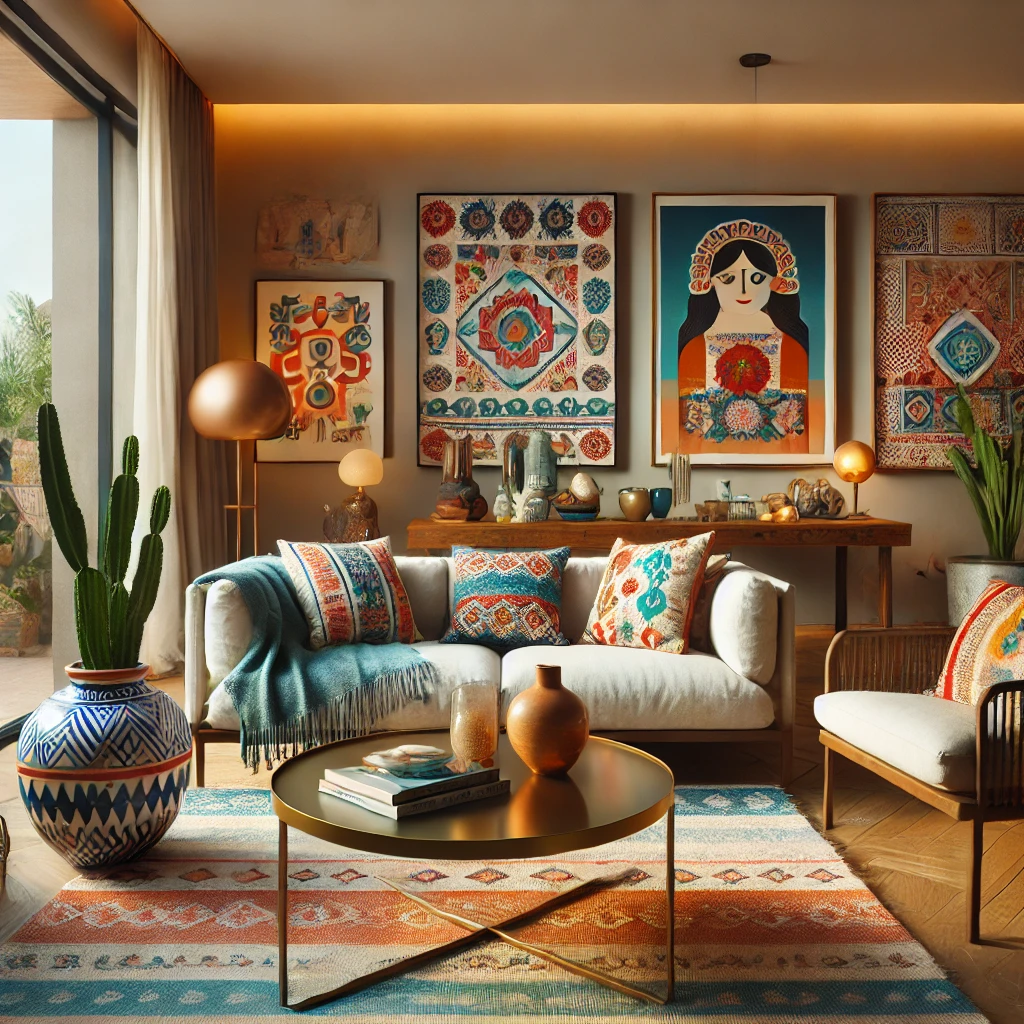Table of Contents
Introduction to Japanese Aesthetics
Japanese aesthetics encompasses a unique and profound approach to beauty, significantly influenced by cultural, historical, and philosophical elements unique to Japan. At its core, Japanese aesthetics emphasizes simplicity, naturalness, and an appreciation for imperfection, known in Japanese as ‘Wabi-Sabi.’ This philosophy finds its roots in Zen Buddhism, which fosters a mindful approach to life and a deep respect for nature. It encourages individuals to appreciate the transient beauty found in the world around them, often reflected in traditional Japanese art forms, architecture, and design.
Simplicity is a fundamental aspect of Japanese aesthetics. This principle advocates for the elimination of unnecessary elements, fostering a calm and uncluttered environment. In traditional Japanese design, this can be seen in the minimalist interiors of tatami mat rooms, characterized by their clear lines and modest furnishings. Such environments are conducive to contemplation and promote a sense of peace, illustrating how design can directly influence emotional well-being.
Naturalness, another key element of Japanese aesthetics, emphasizes harmony with the environment. This principle encourages designers to draw inspiration from nature, integrating natural materials and organic forms into their work. For instance, the use of wood, stone, and paper in traditional crafts exemplifies how authenticity in materials enhances a space’s intrinsic beauty.
Finally, the notion of Wabi-Sabi celebrates imperfection, irregularity, and the passage of time. It reveals a different perspective on beauty, where scars, blemishes, and wear are viewed as signs of authenticity and history. This approach stands in stark contrast to the obsession with perfection often seen in modern design. Collectively, these principles of Japanese aesthetics serve as a foundation for understanding their profound influence on contemporary global design trends, offering fresh perspectives that transcend geographical boundaries.

Historical Context of Japanese Aesthetics
The historical evolution of Japanese aesthetics is a rich tapestry interwoven with diverse cultural, philosophical, and artistic influences. Rooted in ancient practices, these aesthetic principles have developed through several significant periods and movements, contributing to their modern appeal. The earliest expressions of Japanese aesthetics can be traced back to the Jomon period (approximately 14,000 BC to 300 BC), characterized by distinctive pottery and an intrinsic connection to nature, reflected in the forms and textures of their artifacts.
As Buddhism was introduced from China in the 6th century, it brought with it new artistic and philosophical concepts, particularly from Zen Buddhism. This period saw the emergence of a minimalistic approach, exemplified in Noh theater and tea ceremonies, which emphasized simplicity, harmony, and the beauty of imperfection—a principle known as wabi-sabi. These ideas profoundly influenced various Japanese art forms, including painting, pottery, and architecture, promoting an aesthetic that values restraint and the natural world.
The Edo period (1603-1868) marked another pivotal era, as urban culture flourished and techniques such as ukiyo-e (woodblock printing) gained popularity. Artists like Hokusai and Hiroshige encapsulated fleeting moments of beauty and daily life, making these artworks widely accessible and further ingraining Japanese aesthetics in the global consciousness. The Meiji Restoration (1868) ushered in modernization and an interaction with Western styles, leading to a unique synthesis. Despite the infusion of foreign elements, traditional Japanese aesthetics continued to thrive, demonstrating adaptability while retaining their core values.
In contemporary design, the influence of Japanese aesthetics can be seen globally in architecture, fashion, and product design. Their principles are celebrated for promoting sustainability, simplicity, and a deep respect for tradition, ensuring that the impact of Japanese aesthetics remains profound and enduring across various cultures and artistic expressions.
Key Principles of Japanese Design
Japanese design is characterized by several fundamental principles that have transcended cultural boundaries and influenced global design trends. Among these principles, minimalism stands out as a defining feature. The essence of minimalism in Japanese aesthetics revolves around simplicity and the elimination of unnecessary elements. This approach allows for a focus on the purity of form and function, creating spaces and objects that are uncluttered and serene. In architecture and interior design, minimalism emphasizes clean lines, open spaces, and a disciplined color palette, fostering a sense of calm that resonates with users.
Another pivotal aspect of Japanese design is asymmetry. Contrary to Western notions of balance, Japanese aesthetics often embrace an intentional off-kilter arrangement. This principle is evident in traditional gardens, art, and even the arrangement of tea ceremonies, where asymmetry creates a dynamic interaction with space and emphasizes the beauty of imperfection. It allows for a unique visual tension that invites contemplation and engagement, aligning with the philosophies of wabi-sabi, which finds beauty in the transient and imperfect.
The connection to nature is also a salient principle in Japanese design. Nature is not merely a backdrop but an integral component that informs the aesthetic choices made by designers. This connection can be observed in the use of natural materials, such as wood and stone, as well as in the incorporation of natural light and outdoor views in architectural practices. Japanese gardens, for example, are meticulously designed to simulate natural landscapes, promoting harmony between the built environment and the surrounding ecosystem. This organic approach has inspired various international design movements, advocating for sustainability and a deeper relationship with nature.
Overall, the interplay of minimalism, asymmetry, and a strong connection to nature encompasses the core of Japanese design, leaving an indelible mark on various artistic expressions from architecture to product design, and influencing contemporary aesthetics globally.
Japanese Aesthetics in Contemporary Design
In recent years, there has been a notable resurgence of Japanese aesthetics within the sphere of contemporary design, significantly influencing various fields such as architecture, interior design, product design, and fashion. This revival has been catalyzed by a global appreciation for minimalism, craftsmanship, and the profound relationship between nature and design inherent in traditional Japanese principles. Designers around the world are increasingly adopting these ideologies, integrating them into their projects as a means of creating serene, functional, and visually appealing spaces and objects.
One of the notable examples of this influence can be seen in the work of architects like Tadao Ando and Kengo Kuma. Their designs showcase the seamless integration of nature with modern architecture, utilizing materials such as wood, stone, and water to create spaces that evoke simplicity and tranquility. Tadao Ando’s Church of the Light, for instance, exemplifies how light and shadow are manipulated to enhance the spiritual experience, a fundamental aspect of Japanese aesthetics. Similarly, Kuma’s approach emphasizes a dialogue between human activity and the natural environment, aligning closely with principles of Feng Shui and biophilic design.
In the realm of product design, brands like Muji illustrate how Japanese aesthetics can redefine consumer products by favoring simplicity and functionality over excessive ornamentation. Their offerings emphasize a “less is more” philosophy, resonating with contemporary lifestyles that prioritize sustainability and minimalism. In fashion, designers such as Issey Miyake and Yohji Yamamoto draw inspiration from traditional Japanese clothing, utilizing innovative materials and techniques to create garments that merge heritage with a forward-thinking approach.
Overall, the blending of traditional Japanese aesthetics with modern design practices is not merely a trend, but a transformative movement that continues to resonate globally, highlighting the enduring appeal and relevance of these time-honored principles in contemporary design practices.
Influence on Interior Design Trends
Japanese aesthetics have had a profound impact on interior design trends across the globe, emphasizing simplicity, functionality, and a deep connection with nature. One of the most prominent aspects of this influence is the shift towards the use of natural materials. Designers increasingly incorporate elements such as wood, stone, and bamboo in their spaces, echoing the traditional Japanese philosophy of harmonizing with the environment. This trend often manifests through the use of shoji screens, tatami mats, and organic textures, providing a serene and calming ambiance in various settings.
Another significant principle derived from Japanese aesthetics is the concept of open spaces, which encourages a flow between indoor and outdoor living. This design philosophy can be observed in modern homes that feature large windows and sliding doors, inviting natural light and facilitating a seamless transition to gardens or terraces. Such open layouts not only enhance spatial perception but also promote a sense of tranquility, mirroring the peaceful qualities found in traditional Japanese architecture. The minimalist approach, characterized by uncluttered spaces, further aligns with this openness, allowing essential elements to stand out while ensuring a harmonious experience.
Furthermore, the focus on simplicity in design is evident in the incorporation of multifunctional furniture and decor that emphasizes practicality without sacrificing aesthetics. Items such as low-profile seating and modular shelving units enable efficient use of space while adhering to minimalist ideals. Case studies, such as the implementation of Zen gardens in urban apartments, illustrate how these principles create tranquil retreats that resonate with contemporary lifestyles. As global design trends continue to evolve, the enduring influence of Japanese aesthetics proves that functionality and beauty can coexist, inspiring designers to create spaces rooted in mindfulness and respect for nature.
Impact on Fashion and Textile Design
Japanese aesthetics have significantly influenced contemporary fashion and textile design, captivating designers and consumers alike with their unique characteristics. Traditional Japanese motifs, such as cherry blossoms, cranes, and waves, have found their way into modern clothing lines, bringing an element of cultural richness and symbolism. Designers are increasingly integrating these timeless patterns and techniques to create collections that resonate with both Western and Eastern sensibilities.
Notable collaborations between Japanese artisans and global fashion brands underline the value placed on craftsmanship and heritage in modern design. For instance, collaborations between luxury brands and traditional textile specialists result in unique pieces that celebrate the meticulous handwork characteristic of Japanese fabric-making. Techniques like indigo dyeing, Sashiko stitching, and the use of natural fibers echo a commitment to quality, which is becoming more essential in the ever-evolving fashion landscape.
The trend towards sustainable fashion particularly aligns with traditional Japanese values that emphasize durability, functionality, and aesthetic simplicity. Many contemporary designers are adopting a minimalist approach that reflects the principles of Wabi-Sabi, which celebrates imperfection and transience. This philosophy encourages consumers to appreciate garments as enduring pieces rather than disposable items, thus promoting a more conscious consumption of fashion.
As awareness grows regarding the negative impacts of fast fashion, the adoption of Japanese aesthetics paves the way for a new design narrative that prioritizes sustainability without compromising on artistry. By honoring traditional Japanese techniques, designers offer innovative collections that not only maintain cultural significance but also adapt seamlessly to modern lifestyle demands. This fusion of old and new continues to redefine global design trends, ensuring that the impact of Japanese aesthetics remains a vital force in fashion and textile design.
The Role of Technology in Promoting Japanese Aesthetics
In the contemporary digital landscape, technology has emerged as a pivotal force in disseminating Japanese aesthetics across a global audience. The proliferation of social media platforms such as Instagram, Pinterest, and TikTok serves as a catalyst for cultural exchange, enabling users to explore and appreciate Japanese design elements, from minimalist interiors to intricate textile patterns. The visual nature of these platforms allows for the rapid sharing of images and videos, effectively bridging geographical boundaries and introducing diverse audiences to the elegance inherent in Japanese aesthetics.
Moreover, online communities have flourished around these aesthetic principles, fostering spaces where individuals can share their interpretations and adaptations of traditional Japanese design. Forums and groups dedicated to discussions about wabi-sabi, Zen gardens, and Japanese architecture promote a deeper understanding of these cultural traits. Users not only consume content but also engage in creative expression, resulting in a hybridization of styles that infuses local influences with Japanese sensibilities.
Digital design platforms further amplify this trend by offering artists and designers tools to incorporate Japanese aesthetics into their work. Software such as Adobe Creative Suite and Procreate enables creators to experiment with various design motifs, patterns, and color palettes inspired by Japan’s rich artistic heritage. This access to technology democratizes the design process, allowing anybody with a passion for aesthetics to contribute their own unique perspective. Influencers in the design realm leverage their reach to showcase Japanese-inspired work, effectively positioning these aesthetics within contemporary design narratives.
Through the convergence of social media, online communities, and digital design tools, technology not only promotes but also evolves Japanese aesthetics, allowing them to resonate with varied cultures worldwide. This transformative interaction cultivates a global appreciation for the nuanced beauty found within Japanese art and design, paving the way for innovative interpretations and collaborations.
Case Studies of Global Designers Embracing Japanese Aesthetics
Japanese aesthetics have transcended cultural boundaries, leaving a lasting impact on various global design landscapes. Renowned designers and brands have embraced these principles, often resulting in a harmonious blend of tradition and modernity. One prominent example is the fashion designer Yohji Yamamoto, whose work resonates with the minimalist ethos often associated with Japanese artistry. His collections frequently highlight voluminous silhouettes, natural fabrics, and subtle color palettes, all of which draw from traditional Japanese clothing styles. This unique approach has made his brand a hallmark of avant-garde fashion while simultaneously honoring cultural heritage.
Another exemplary figure is Tadao Ando, a globally recognized architect known for his adept incorporation of simplicity and nature in his creations. Ando’s works, such as the Water Temple in Awaji, Japan, exemplify the Japanese concept of ‘ma’—the experiential space between objects. His architectural philosophy emphasizes serenity and mindfulness, with buildings that seamlessly blend with their surroundings. The influence of Ando’s designs extends beyond Japan, inspiring architects worldwide to adopt similar practices that celebrate the environment and foster a sense of tranquility.
In the realm of product design, the Muji brand stands as a testament to the power of Japanese aesthetics. With its commitment to simplicity, functionality, and sustainability, Muji transcends mere consumerism by prioritizing user experience and environmental consciousness. Their minimalist designs, free from excessive branding and embellishments, reflect the beauty of everyday life, appealing to a broad audience that values authenticity and practicality. This holistic approach showcases how Japanese aesthetic principles can inform global design philosophies, demonstrating not only versatility but also a universal appeal.
Overall, the influence of Japanese aesthetics on global designers is profound, as it encourages a mindful approach to design that values simplicity, functionality, and a deep respect for nature and tradition.
The Future of Japanese Aesthetics in Global Design
The future of Japanese aesthetics within global design trends is poised for further evolution as cultural exchanges continue to intensify. As the world becomes increasingly interconnected, the principles of Japanese design—rooted in simplicity, elegance, and a deep respect for nature—are likely to remain influential. This influence is seen not only in architecture and interior design but extends to fashion, graphic design, and product development. The resurgence of interest in minimalism aligns well with these principles, providing a fertile ground for the integration of Japanese aesthetics into contemporary practices.
Moreover, the growing global emphasis on sustainability can be anticipated to reflect the inherent values found in Japanese design. Concepts such as ‘wabi-sabi’, which celebrates the beauty of imperfection and transience, resonate well with the current trend of environmental consciousness. Products designed with a focus on longevity, practicality, and a connection to natural materials will likely gain further traction, thus reinforcing the role of Japanese aesthetics in shaping sustainable design practices worldwide.
Cultural fusion is another crucial element that will affect the trajectory of Japanese design in the future. As designers and artists collaborate across borders, the blend of Eastern and Western influences may yield innovative forms that honor traditional Japanese aesthetics while also embracing contemporary trends. This harmonious amalgamation could provide fresh interpretations of classic Japanese motifs, further expanding their relevance and application in global design contexts.

In conclusion, the future of Japanese aesthetics is bright within the realm of global design. As sustainability gains prominence and cultural boundaries blur, the profound simplicity and elegance of Japanese design principles are positioned to inspire and influence new generations of designers. The continuing appreciation for these values promises to sustain their legacy in the global design narrative.





